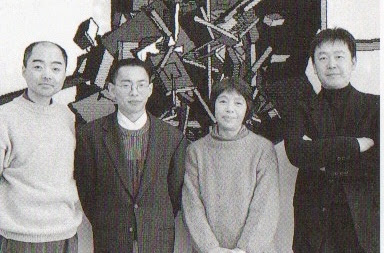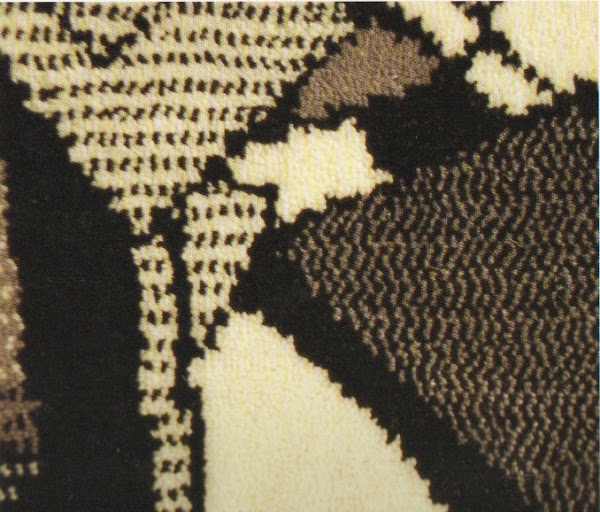Preamble
For your convenience I have listed below other post in this series:
Fourth International Textile Competition '94 Kyoto - Part I
Fourth International Textile Competition '94 Kyoto - Part II
Fourth International Textile Competition '94 Kyoto - Part III
Fourth International Textile Competition '94 Kyoto - Part IV
Fourth International Textile Competition '94 Kyoto - Part V
Fourth International Textile Competition '94 Kyoto - Part VI
Fourth International Textile Competition '94 Kyoto - Part II [1]
(i) Naoto Izukura (Kyoto, Japan). Outstanding Award.
Background: Born in 1971, Naoto Izukura graduated from Doshisha University. He studied at ESMODE in Paris. He participated in the International Textile Competition in 1992. He researches in natural dyeing.
Naoto Izukura.
Artist: Naoto Izukura.
Title: Materialism.
Materials: Silk (scraped cocoons).
Technique: Natural dyeing, silk thread making.
Size: 200 (width) x 610 (depth) cm.
Detailed View.
Judges' Comment: When manufacturing silks, the first 100 meters and the last 1100 meters of the thread is excluded from industrial standards, and discarded. Known as 'worthless silk', this material is the perfect medium for a powerful expression of presence by the artists concerning the contradictions of an industrial society which values only profitable achievement. This expression of presence is in fact an expression of the material itself. Using only natural dyes extracted from plants, the artist has taken the theme of this competition and has worked and reworked it; the answer will be provided by those who come to see.
It is indeed a sharp anti-thesis and warning for this industrial society by an artist who possesses a deep love for materials used in his work. The time has come for us to consider very carefully the affluence we thought we had achieved. This work is not an industrial production, nor is it merely a work created through the dexterous techniques at the command of the artist. Searching through the depths of possibility contained within textiles themselves, it is this search itself which has given this work its profunity, and its high evaluation by ITF.
(ii) Noise Dance Industrial. Design Award. Principal Creator: Mitsuo Toyazaki.
A collaborative work. From far right: Mitsuo Toyazaki (Principal creator) with co-creators: Akira Koyama, Eiji Hashimoto and Mihoko Matsumoto.
Background:
Born in 1955, Mitsuo Toyazaki graduated from Tokyo University of Arts in 1981.
Artists: Mitsuo Toyazaki (Principal creator). Akira Koyama, Eiji Hashimoto and Mihoko Matsumoto (co-creators).
Title: Noise Dance.
Materials: Weaving with OMT.
Technique: Computer Graphics.
Size: 260 (H) x 630 (W) cm.
Detailed View.
Judge's Comment: The employment of computer graphics as an additional technique to be used in the field of textile design was a natural, and epochal development, allowing for what effectively amounts to limitless expansion of possibility, and the induction of computer graphics in the industrial world of textiles will only increase as time passes. However, the introduction of computer graphics in textile design was never intended to be merely a time and labor saving means of greater production efficiency. Its main purpose, and ultimate significance shall be found in the transcendence of function, for this can be considered to be the time of experimentation, a chance to grope for the means of achieving a new generation of textiles through the unpredictable relationship between humans and computer graphics. This work indeed makes one aware of this relationship through its peculiar, three-dimensional expression of the passage of time, made possible by the techniques of computer graphics.
(iii) Gilian Little (UK). Technology Award.
Gilian Little.
Background: Born in 1962, Gilian Little graduated from the West Surrey College of Art and Design from the Royal College of Art, London in 1993. She exhibited at Textprint at Interstoff, Frankfurt in 1994 was commissioned by the Crafts Council Works in 1994.
Artist: Gilian Little.
Title: Brick Linen Devoré.
Materials: Cotton, linen, lambs wool.
Technique: Woven fabric printed with devoré.
Size: 241 (H) x 79 (W) cm.
Detailed View.
Judges' Comment: Devoré is a traditional art whereby cellulose is basically transformed into felt through the chemical organization of layers of natural fibers. The particular appearance of the withering of time exuded by this work has been accomplished through the techniques of devoré weaving. The artist has taken the different, individual characteristics of the natural fibers, cotton, linen and wool, and has woven them into a single, magnificent expression of subtle, hidden possibilities contained in each fiber.
In creating this work of art, the artist has paid particular attention to the expression of materials. Through her masterful use of texture, she has created a work which makes one strongly re-evaluate the position of natural materials, and resounds as a chilling warning to those who would de-predate nature.
Notwithstanding, this work is permeated with classical beauty and leisurely atmosphere designed to give forth a sense of peace and harmony as one gazes upon it.
Reference:
[1] Edited by: International Textile Fair Executive Committee.
Published by: International Textile Fair Executive Committee (Nishijin-ori-Kiakan, Horikawa Imadegawa, Kamigyo-ku, Kyoto 602,Japan.
Printed by: New Color Photographic Printing Co. Ltd. © 1994 International Textile Fair Executive Committe.
For your convenience I have listed below other post in this series:
Fourth International Textile Competition '94 Kyoto - Part I
Fourth International Textile Competition '94 Kyoto - Part II
Fourth International Textile Competition '94 Kyoto - Part III
Fourth International Textile Competition '94 Kyoto - Part IV
Fourth International Textile Competition '94 Kyoto - Part V
Fourth International Textile Competition '94 Kyoto - Part VI
Fourth International Textile Competition '94 Kyoto - Part II [1]
(i) Naoto Izukura (Kyoto, Japan). Outstanding Award.
Background: Born in 1971, Naoto Izukura graduated from Doshisha University. He studied at ESMODE in Paris. He participated in the International Textile Competition in 1992. He researches in natural dyeing.
Naoto Izukura.
Artist: Naoto Izukura.
Title: Materialism.
Materials: Silk (scraped cocoons).
Technique: Natural dyeing, silk thread making.
Size: 200 (width) x 610 (depth) cm.
Detailed View.
Judges' Comment: When manufacturing silks, the first 100 meters and the last 1100 meters of the thread is excluded from industrial standards, and discarded. Known as 'worthless silk', this material is the perfect medium for a powerful expression of presence by the artists concerning the contradictions of an industrial society which values only profitable achievement. This expression of presence is in fact an expression of the material itself. Using only natural dyes extracted from plants, the artist has taken the theme of this competition and has worked and reworked it; the answer will be provided by those who come to see.
It is indeed a sharp anti-thesis and warning for this industrial society by an artist who possesses a deep love for materials used in his work. The time has come for us to consider very carefully the affluence we thought we had achieved. This work is not an industrial production, nor is it merely a work created through the dexterous techniques at the command of the artist. Searching through the depths of possibility contained within textiles themselves, it is this search itself which has given this work its profunity, and its high evaluation by ITF.
(ii) Noise Dance Industrial. Design Award. Principal Creator: Mitsuo Toyazaki.
A collaborative work. From far right: Mitsuo Toyazaki (Principal creator) with co-creators: Akira Koyama, Eiji Hashimoto and Mihoko Matsumoto.
Background:
Born in 1955, Mitsuo Toyazaki graduated from Tokyo University of Arts in 1981.
Artists: Mitsuo Toyazaki (Principal creator). Akira Koyama, Eiji Hashimoto and Mihoko Matsumoto (co-creators).
Title: Noise Dance.
Materials: Weaving with OMT.
Technique: Computer Graphics.
Size: 260 (H) x 630 (W) cm.
Detailed View.
Judge's Comment: The employment of computer graphics as an additional technique to be used in the field of textile design was a natural, and epochal development, allowing for what effectively amounts to limitless expansion of possibility, and the induction of computer graphics in the industrial world of textiles will only increase as time passes. However, the introduction of computer graphics in textile design was never intended to be merely a time and labor saving means of greater production efficiency. Its main purpose, and ultimate significance shall be found in the transcendence of function, for this can be considered to be the time of experimentation, a chance to grope for the means of achieving a new generation of textiles through the unpredictable relationship between humans and computer graphics. This work indeed makes one aware of this relationship through its peculiar, three-dimensional expression of the passage of time, made possible by the techniques of computer graphics.
(iii) Gilian Little (UK). Technology Award.
Gilian Little.
Background: Born in 1962, Gilian Little graduated from the West Surrey College of Art and Design from the Royal College of Art, London in 1993. She exhibited at Textprint at Interstoff, Frankfurt in 1994 was commissioned by the Crafts Council Works in 1994.
Artist: Gilian Little.
Title: Brick Linen Devoré.
Materials: Cotton, linen, lambs wool.
Technique: Woven fabric printed with devoré.
Size: 241 (H) x 79 (W) cm.
Detailed View.
Judges' Comment: Devoré is a traditional art whereby cellulose is basically transformed into felt through the chemical organization of layers of natural fibers. The particular appearance of the withering of time exuded by this work has been accomplished through the techniques of devoré weaving. The artist has taken the different, individual characteristics of the natural fibers, cotton, linen and wool, and has woven them into a single, magnificent expression of subtle, hidden possibilities contained in each fiber.
In creating this work of art, the artist has paid particular attention to the expression of materials. Through her masterful use of texture, she has created a work which makes one strongly re-evaluate the position of natural materials, and resounds as a chilling warning to those who would de-predate nature.
Notwithstanding, this work is permeated with classical beauty and leisurely atmosphere designed to give forth a sense of peace and harmony as one gazes upon it.
Reference:
[1] Edited by: International Textile Fair Executive Committee.
Published by: International Textile Fair Executive Committee (Nishijin-ori-Kiakan, Horikawa Imadegawa, Kamigyo-ku, Kyoto 602,Japan.
Printed by: New Color Photographic Printing Co. Ltd. © 1994 International Textile Fair Executive Committe.










No comments:
Post a Comment